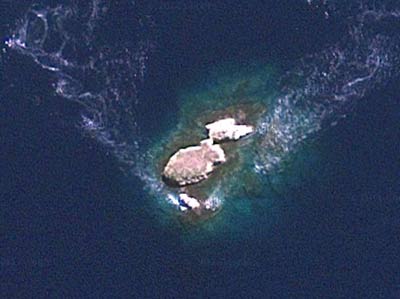|
Michael McFadyen's Scuba Diving - Batu Bolong, Indonesia
In September 2012 Kelly and I did a week long liveaboard dive trip in Indonesia which went from Bali to Komodo and back. We went on the MV Mermaid II. Click here to read about the boat. This is one of the dive sites we did on the trip. The trip heads north-east from Benoa Harbour on Bali out north of Lombok and then north of the other islands to Komodo Island and then down the eastern side of Komodo to the southernmost point of Komodo. For all dives on this trip we used 31% Nitrox, so bear this in mind when considering the bottom times we did.
Batu Bolong is a smallish rock that comes up from 40+ metres and is located towards the northern end of Linta Strait, the waterway that runs between Komodo and Rinja (Rinca) Islands. An approximate GPS mark for the dive spot is 8° 32' 17.5"S 119° 36' 38.4"E (using WGS84 as the datum). The site is east-north-east from the GPS mark.
 |
| A satellite photo from Google Earth that shows the location of the dive site |
Batu Bolong is out in the middle of the strait and is affected to an extent by currents. Accordingly, the side you dive will be determined by the current. The southern side is dived when the current is from the north and the northern side when the current is from the south.
 |
A map of the dive site - north is at the bottom of the map
Used courtesy of Mermaid Cruises |
As with virtually all dive sites that you do when on MV Mermaid II, you use the RIB (rigid inflatable boat) to get to the start of the dive (and also to get back to the boat). The RIB will drop you normally about 20 metres off the rock.
As the current was from the north, we were dropped on the southern side. Once in the water, we dropped to 22 metres on a rock and coral slope. The bottom slopes very steeply, almost vertically on the eastern and western sides, to the depths.
 |  |
| One of the many large barrel sponges | Red gorgonias are all over the place |
 |  |
Kelly on a very colourful
section of the reef | White gorgonia on the wall |
The slope has lots of small gorgonias and small barrel sponges. It is very colourful, with bright sponges and other marine life really making this one of the most attractive dive sites I have ever done.
We work our way around the rock towards the eastern side, dropping to about 30 metres as we go. Once on the eastern side we find the current a bit too strong to make it easy to go past here, so we turn around and go back towards the west. We see a number of turtles in this area, including one that is eating sponges.
There are some huge hump-headed wrasse at this site and a white-tipped reef shark swims by us. There are many firefish (lionfish) and we see a couple more turtles. At the western side we again strike the current. We have gradually ascended to about 16 metres, so we turn and again head east.
 |  |
| A turtle | Kelly videoing another turtle |
This is repeated till we are back at the western side again. Here there are hundreds of small fish eating at something on the rocks. A close examination reveals that they are eating the millions of sergeant major eggs that have been laid on the rocks. A few sergeant majors are trying to defend their offspring without any success. Such is life (as Ned Kelly once said)!
Back towards the south we see two huge moray eels, one the biggest I have ever seen. It is truly enormous but will not come out enough for me to take its photograph. We end the dive in about five metres, spending more than 15 minutes here before we ascended.
 |  |
| Kelly and starry pufferfish | A white-tipped reef shark and a turtle |
After our ascent, we have to wait a while to be picked up as most of the other divers from our boat have ascended at the same time. We stick together and the current swirls and takes us in a large circle away from the rock and back again before we head off to the south. We are finally collected a few hundred metres south of the rock.
This was an really great dive site, perhaps with the most colourful bottom I have ever seen. The visibility was 30 metres and the water temperature was about 27°C.
Click here to return to the list of sites we did on our MV Mermaid II trip.
| 
 v6.00.307 © 2003-2005
v6.00.307 © 2003-2005